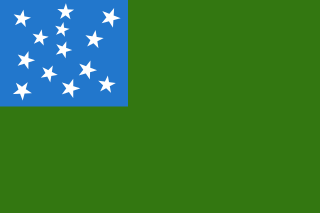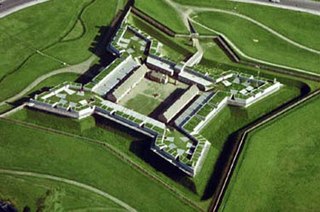Related Research Articles

The Green Mountain Boys were a militia organization established in 1770 in the territory between the British provinces of New York and New Hampshire, known as the New Hampshire Grants and later in 1777 as the Vermont Republic. Headed by Ethan Allen and members of his extended family, it was instrumental in resisting New York's attempts to control the territory, over which it had won de jure control in a territorial dispute with New Hampshire.

Barrimore Matthew "Barry" St. Leger was a British Army officer. St. Leger was active in the Saratoga Campaign, commanding an invasion force that unsuccessfully besieged Fort Stanwix. St. Leger remained on the frontier for the duration of the war; after its conclusion, he served briefly as commander of British forces in Quebec.

The Battle of Oriskany was a significant engagement of the Saratoga campaign of the American Revolutionary War, and one of the bloodiest battles in the conflict between the Americans and Great Britain. On August 6, 1777, a party of Loyalists and several hundred Indian allies from different tribes ambushed an American military party that was marching to relieve the siege of Fort Stanwix. This was one of the few battles in which the majority of the participants were Americans; Patriots and allied Oneidas fought against Loyalists and allied Iroquois in the absence of British regular soldiers. There was also a detachment of Hessians in the British force, as well as Western Indians including members of the Mississaugas.

Brigadier General Nicholas Herkimer was an American military officer who fought during the Revolutionary War. He died of wounds after the Battle of Oriskany.

John Butler was an American-born military officer, landowner, merchant and colonial official in the British Indian Department. During the American Revolutionary War, he was a prominent Loyalist who led the provincial regiment known as Butler's Rangers on the frontiers of New York and Pennsylvania. Born in Connecticut, he moved to New York with his family, where he learned several Iroquoian languages and worked as an interpreter in the fur trade. He was well-equipped to work with Mohawk and other Iroquois warriors who became allies of the British during the rebellion.

Adam Frederick Helmer, also known as John Adam Frederick Helmer and Hans Adam Friedrich Helmer, was an American Revolutionary War hero among those of the Mohawk Valley and surrounding regions of New York State. He was made nationally famous by Walter D. Edmonds' popular 1936 novel Drums Along the Mohawk with its depiction of "Adam Helmer's Run" of September 16, 1778, to warn the people of German Flatts of the approach of Joseph Brant and his company of Indians and Tories.

The King's Royal Regiment of New York, also known as Johnson's Royal Regiment of New York, King's Royal Regiment, King's Royal Yorkers, and Royal Greens, were one of the first Loyalist regiments, raised on June 19, 1776, in British Canada, during the American Revolutionary War.

The 1st Rhode Island Regiment was a regiment in the Continental Army raised in Rhode Island during the American Revolutionary War (1775–83). It was one of the few units in the Continental Army to serve through the entire war, from the siege of Boston to the disbanding of the Continental Army on November 3, 1783.
The Hillsborough District Brigade of militia was an administrative division of the North Carolina militia established on May 4, 1776. Brigadier General Thomas Person was the first commander. Companies from the eight regiments of the brigade were engaged in 55 known battles and skirmishes in North Carolina, South Carolina, and Georgia during the American Revolutionary War. It was active until the end of the war.

The siege of Fort Stanwix in 1777 began on August 2 and ended August 22. Fort Stanwix, in the western part of the Mohawk River Valley, was then the primary defense point for the Continental Army against British and Indian forces aligned against them in the American Revolutionary War. The fort was occupied by Continental Army forces from New York and Massachusetts under the command of Colonel Peter Gansevoort. The besieging force was composed of British regulars, American Loyalists, Hessian soldiers from Hesse-Hanau, and Indians, under the command of British Brigadier General Barry St. Leger and the Iroquois leader Joseph Brant. St. Leger's expedition was a diversion in support of General John Burgoyne's campaign to gain control of the Hudson River Valley to the east.
1st American Regiment, also known as Jackson's Continental Regiment of 1783–1784, was the last unit in the Continental Army, retained after the close of the American Revolutionary War. This regiment, under the command of Colonel Henry Jackson of Massachusetts, was not the same unit as Jackson's Additional Continental Regiment of 1777, which had become the 16th Massachusetts Regiment in 1780 and had been disbanded in 1781. Equally, this regiment should not be confused with the First American Regiment of 1784–1791, which was originally commanded by Colonel Josiah Harmar, has remained in service to the present, and is now the 3d United States Infantry Regiment.
Johan Jost Herkimer was a Loyalist born in 1732, the second of five sons of Johan Jost Herkimer and Anna Catherine Petri of German Flatts, Province of New York. He was the younger brother of the American Patriot General Nicholas Herkimer.
The Adjutant General of Maryland is the head military official of the Maryland National Guard, the Maryland Defense Force, and any other military or paramilitary units that may be maintained by the State of Maryland. The adjutant general is responsible for the military department's budget and maintains all State-owned armories in Maryland.
The Rowan County Regiment was originally established in about August 1, 1775 as a local militia in Rowan County in the Province of North-Carolina. When the North Carolina Provincial Congress authorized thirty-five existing county militias to be organized on September 9, 1775, the Rowan County Regiment was included and all officers were appointed with commissions from the Provincial Congress. The members of the Rowan County Regiment were mostly from what was Rowan County at the time. Prior to establishment of the Rowan County Regiment, many of its officers were active in the Rowan County Committee of Safety. The regiment included 160 known companies and one or more of these companies were engaged in 36 known battles or skirmishes during the American Revolution. After the establishment of the Rowan County Regiment, several other counties were created from Rowan County, including Burke County in 1777, Iredell County in 1788, Davidson County in 1822 and Davie County in 1836.
The Rutherford County Regiment was authorized on October 30, 1779, by the Province of North Carolina Congress. It was created at the same time that Rutherford County, North Carolina was created out of the western part of Tryon County, North Carolina when Tryon County and its regiment of militia were abolished. Officers were appointed and commissioned by the Governor. The regiment was engaged in battles and skirmishes against the British during the American Revolution in North Carolina, Georgia, and South Carolina between 1779 and 1782. It was active until the end of the war.

The Halifax District Brigade was an administrative division of the North Carolina militia during the American Revolutionary War (1776–1783). This unit was established by the North Carolina Provincial Congress on May 4, 1776, and disbanded at the end of the war.
North Carolina state troops in the American Revolution were the initial military units created in a transition from the Province of North Carolina under British rule to independence from British rule. Most units did not last long as such and were either transferred to the Continental Army or state militia instead.
Colonel John Sheppard was a Revolutionary War soldier and commander of the Wayne County Regiment of the North Carolina militia. His father, Abraham Sheppard was a planter, politician, and commander of the Dobbs County Regiment and 10th North Carolina Regiment. He also had a brother, Abraham Sheppard, Jr., who served with John in the Dobbs County Regiment.
References
- Berry, A.J., A Time of Terror, 2005, ISBN 1-4120-6527-5
- Fernow, Berthold (1887). New York in the Revolution. OL 25266301M.
- DRCHSNY, Vol.1 Fernow, Bethold, Documents Relating to the Colonial History of the State of New York: Volume XV: State Archives Series, Volume 1., 1887 [DRCHSNY]. Weed, Parsons, & Company: Albany, New York, 1887"
- Fonte, Allan, Liberty March, The Battle of Oriskany, 1998, ISBN 0-925168-72-6
- Fort Plank Historian, Ken D. Johnson, The Bloodied Mohawk, Picton Press, Rockport, Maine, 2000, ISBN 0-89725-399-X.
- Pettingell, James Mason, "A Pettingell Genealogy", The Fort Mill Press, Boston, Mass., 1906, ISBN 1-4370-1551-4